
Publisher:
Bonnie King
CONTACT:
Newsroom@Salem-news.com
Advertising:
Adsales@Salem-news.com

~Truth~
~Justice~
~Peace~
TJP
Feb-11-2010 19:24

 TweetFollow @OregonNews
TweetFollow @OregonNews
The 42nd Anniversary of the Tet Offensive
Chuck Palazzo Salem-News.comThe fighting that happened during Tet in '68 continues to claim victims.
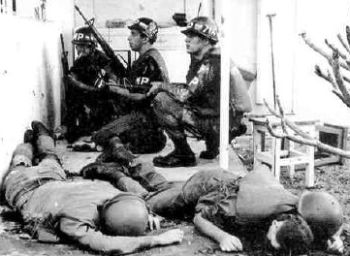 Infamous photo of soldiers kneeling at the U.S. Consulate building during the Tet Offensive. |
(DANANG, Vietnam) - Much of this is taken from public record – actually most of it is. I add my comments here and there, but as I approach this year’s Tet – The Lunar New Year – which occurs on February 14, this year, I wanted to take pause and remind us all of that bloody and gruesome series of events.
Another reminder was what occurred this week near Khe Sanh – the former Marine base best known for what occurred there, and then beyond, during January 1968 and for months that followed. Four locals from the Van Kieu ethnic minority were seriously wounded while they were weeding at a coffee plantation near the former base at Khe Sanh last Sunday. A remnant of that event? Possibly[1].
The Tet Offensive was a military campaign during the Vietnam War that began on January 31, 1968. Forces of the National Liberation Front for South Vietnam (Viet Cong), and the People's Army of Vietnam (the North Vietnamese army), fought against the forces of the Republic of Vietnam (South Vietnam), the United States, and their allies.
The purpose of the offensive was to strike military and civilian command and control centers throughout South Vietnam and to spark a general uprising among the population that would then topple the Saigon government, thus ending the war in a single blow.
The operations are referred to as the Tet Offensive because they began during the early morning hours of 31 January 1968, Tết Nguyên Đán, the first day of the year on a traditional lunar calendar and the most important Vietnamese holiday.
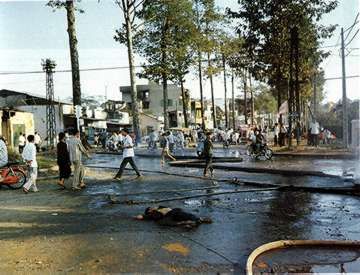 The Tet Offensive in 1968. Photo courtesy: State of Maine |
Both North and South Vietnam announced on national radio broadcasts that there would be a two-day cease-fire during the holiday. In Vietnamese, the offensive is called Cuộc Tổng tiến công và nổi dậy ("General Offensive and Uprising"), or Tết Mậu Thân (Tet, year of the monkey).
The NLF launched a wave of attacks on the morning of 31 January in the I and II Corps Tactical Zones of South Vietnam. This early attack did not, however, cause undue alarm or lead to widespread defensive measures.
When the main NLF operation began the next morning, the offensive was countrywide in scope and well coordinated, with more than 80,000 NVA and NLF troops striking more than 100 towns and cities, including 36 of 44 provincial capitals, five of the six autonomous cities, 72 of 245 district towns, and the southern capital. The offensive was the largest military operation yet conducted by either side up to that point in the war.
The initial attacks stunned the US and South Vietnamese armies and took them by surprise, but most were quickly contained and beaten back, inflicting massive casualties on NVA and NLF forces.
During the Battle of Hue intense fighting lasted for a month and the NLF executed thousands of residents in the Massacre at Hue. Around the US combat base at Khe Sanh fighting continued for two more months. Although the offensive was a military defeat for the NVA and NLF, it had a profound effect on the US government and shocked the American public, which had been led to believe by its political and military leaders that the NVA and NLF were, due to previous defeats, incapable of launching such a massive effort.
Both sides had compelling military reasons for their interest in the region around Khe Sanh. The geography of Indochina made Khe Sanh militarily significant. General Westmoreland felt the critical importance of Khe Sanh was clearly apparent.
It would serve as a patrol base for the interdiction of enemy personnel and supplies coming down the Ho Chi Minh Trail from Laos into northern South Vietnam, a base for covert operations to harass the NVA and NLF along the Trail, the location of an airstrip for aerial reconnaissance of the Trail, the western anchor for the defensive line along the Demilitarized Zone (DMZ) separating North and South Vietnam, and a jumping-off point for a land invasion of Laos to cut the Ho Chi Minh Trail.
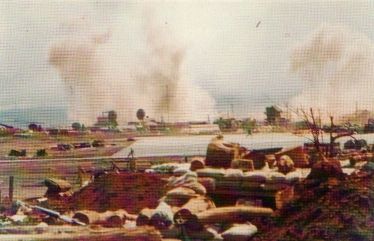 Khe Sanh Courtesy: Wikipedia |
According to Westmoreland, abandoning the US military presence at Khe Sanh would allow the People's Army of Vietnam (PAVN, the North Vietnamese Army or NVA) the ability to carry the fight into the populated coastal regions of Northern South Vietnam. For the NVA and NLF the region around Khe Sanh was the avenue for their entry into northern South Vietnam. From a strategic standpoint, it would clearly be in the best interests of the PAVN to end the American presence at Khe Sanh.
Khe Sanh was located on Route 9 which ran from near the South China Sea at Dong Ha westerly to Savannaket, a market town in Laos along the Mekong River. This old French highway ran just south of and mostly parallel to the Demilitarized Zone. In August, 1967, NVA and NLF forces destroyed many of the bridges on Route 9, blocked the passes, and mined the highway. Khe Sanh was effectively isolated from overland resupply and would remain so for the next nine months. The Marine garrison at the Khe Sanh Combat Base could only be provisioned by air.
In October, 1967, General Giap ordered men and material sent down the Ho Chi Minh Trail and infiltrated across the Laotian-South Vietnam border in the vicinity of Khe Sanh. In response, General Westmoreland ordered the reinforcement of the Marine garrison there.
Westmoreland wanted a large Marine force at Khe Sanh in order to entice PAVN troops into a killing zone where massive firepower would destroy them in large numbers. The limiting factor was that this force had to be small enough to be supplied by air. The result was a reinforced Marine regiment of about 6,600 men. On January 21, 1968, the PAVN began rocket, artillery, and mortar attacks on the Khe Sanh Combat Base.
US air and artillery assets prevented the enemy from massing his forces in sufficient number to launch effective ground attacks on the base and surrounding hilltop positions. As long as Khe Sanh could be adequately supplied with ammunition, POL (petroleum, oil, lubricants) and food, the Marines could maintain their positions.
Concerns over the ability of the US to successfully defend Khe Sanh were manifest at the highest levels of government. President Lyndon B. Johnson, his national security advisor, the advisor's military assistant, and the National Security Council staff representative for Vietnam were all kept abreast of the developing situation around Khe Sanh.
President Johnson summed up his feelings regarding Khe Sanh while the fighting was in progress: "I don't want any damn Dinbinphoo." Both General Earl G. Wheeler, Chairman of the Joint Chiefs of Staff, and General Westmoreland assured the president that preparations for the defense of Khe Sanh were adequate and that the base would be successfully supplied. Support for the defense of Khe Sanh received priority over all other operations in Vietnam.
The job of supplying the Marine base at Khe Sanh fell to various Marine Corps and US Air Force aviation units. This airlift would have been a massive operation even under ideal circumstances. The purely logistical problems were compounded by poor visibility that fell below minimum requirements for airfield operations 40 percent of the time. The PAVN added to the difficulty by directing a heavy volume of antiaircraft and artillery fire at incoming aircraft.
The resupply process suffered a sharp setback on February 10 when PAVN gunners shot up a Marine C-130, fully laden with fuel bladders, while it was attempting a landing at the Khe Sanh airstrip. Your browser may not support display of this image.
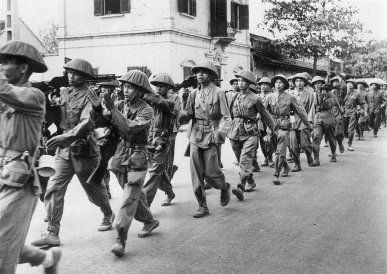 VC preparing for Tet Offensive. Courtesy: hitchcock.itc.virginia.edu |
As a result of this incident and fire damage sustained by other aircraft already on the ground, C-130 landings were temporarily suspended during February. At the beginning of March this suspension was made permanent. Consequently, during these periods, the Marines were denied the use of the best heavy-lift aviation assets in their inventory.
Most supplies thereafter were delivered by parachute. According to the official Marine Corps history of the battle of Khe Sanh, these parachute drops ". . . were sufficient for bulk commodities such as rations and ammunition." Certain supplies, such as replacement troops, medical evacuations and medical supplies could only be delivered by aircraft that made actual landings on the runway at Khe Sanh.
This official assessment of the success of US supply capabilities regarding rations was overly optimistic. A hot meal was defined as heated C-rations; the Marines at Khe Sanh sometimes went weeks without hot meals. Rations were routinely limited to two meals per man per day. One Marine reported that he went several days with only one C-ration meal per day. A company commander on Hill 861, located about two miles northwest of the combat base, reported his men were forced to go for days without water. Another reported that his water ration was one-half canteen cup of water per day, which had to suffice for drinking, shaving, and brushing teeth.
Water is an extremely difficult commodity to deliver to a besieged garrison. It is heavy, it must be handled in special containers that cannot be used for the delivery of other liquids, and water containers are vulnerable to incoming artillery attacks. One helicopter crew attempting to deliver water to Hill 861 was rattled by PAVN fire, panicked, and released its cargo from a height of two hundred feet. The parched Marines watched the water containers burst apart in mid-air.
Had the NVA and NLF realized the vulnerability of the Marine water supply, they could have forced the abandonment of the combat base. The Marines occupied various hilltop positions surrounding Khe Sanh. These positions, initially supplied from the combat base itself, were later provisioned by helicopters flying from the 3d Marine Division Forward base at Dong Ha. Water for the combat base came from the small Rao Quan River which flowed through hills to the north occupied by the PAVN.
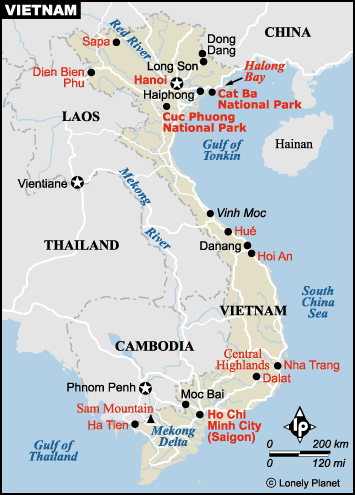 Map of Vietnam in 1968. Courtesy: hitchcock.itc.virginia.edu |
Even though the combat base was not dependent on air-lifted water as the hill positions were, it was, nevertheless, often a scarce commodity. The water point itself was located about 150 meters outside the northern sector of the base perimeter. There was a small hill and tall grass that obscured visual contact with the water point. The water was lifted ninety feet over an 800-foot span by pumps. A dirt dam twenty-five meters wide caused the formation of a reservoir six feet deep.
During the extensive rains of September and October, 1967, the dam broke. US Navy EO1 (Equipment Operator First Class) Rulon V. Rees led a detail to repair the dam in the fall of 1967 using old scrapped Marston matting from the airstrip. This detail blasted a crater in the river bed about thirty feet in front of the dam to act as a reservoir in case the river level fell. Marston matting was placed on the face of the dam.
No patrols went out to get the water. It was pumped inside the perimeter and went to a large black rubber water tower container. This reservoir was frequently punctured during the siege, causing temporary lack of water on the base.
Had the PAVN realized how vulnerable the Marines' water supply was, they could have interdicted it by diverting the Rao Quan River or contaminating it, thereby forcing the Marines to attempt a breakout. However, General Giap, who achieved victory at Dien Bien Phu in part due to his meticulous battlefield planning, seems to have not realized the vulnerability of the Marines' water supply. Nor did the local PAVN commander. General Westmoreland did not become aware of the magnitude of the potential water problem until the base was surrounded by the North Vietnamese. By that time, a successful evacuation was not possible.
The concept of an overland evacuation of a reinforced regiment, fighting its way through two or three PAVN divisions that held every tactical advantage, presented a problem of such magnitude that Westmoreland was reluctant to consider it. The Joint Chiefs refused to consider it.
Had the PAVN succeeded in interdicting the combat base's water supply, 3rd Marine Division commander General R. M. Tompkins is quoted in one source as saying that it would have been impossible to provision Khe Sanh with water in addition to its other resupply requirements. However, in a letter to General Davidson, General Tompkins stated that water could have been added to the provisions already being supplied to support the base. By examining the supply requirements and the logistical capabilities of the Americans it is possible to determine which of these contradictory statements is correct.
III Marine Amphibious Force (III MAF) headquarters established the official supply requirement for Khe Sanh at 235 tons per day. The Americans were hard pressed to meet these requirements. The airstrip was completely closed on various occasions due to the weather or damage sustained from enemy fire. During the month of February alone, the combat base had a deficit of 1,037 tons of supplies actually delivered compared to scheduled deliveries.
The air delivery problems were compounded when the use of the large C-130 cargo planes was curtailed due to hostile fire. Passenger requirements were met by the use of C-123 aircraft. The smaller capacity of the C-123's necessitated a five-fold increase in landings. More landings meant more targets; one aircraft upon returning to Da Nang was found to contain 242 holes before the maintenance personnel gave up counting. In the first month of the siege four major aircraft were lost to hostile fire.
Helicopters were widely used as resupply vehicles. Only helicopters could reach the hilltop positions, whose supply requirements were 32,000 pounds per day. Helicopters were stationed at the combat base at the beginning of the fighting.
These aircraft became so vulnerable to hostile fire that they had to be kept constantly in the air whether they had missions to perform or not. Eventually losses became so great that this unit was deployed away from Khe Sanh, as helicopters were being lost at a rate faster than they could be replaced. No less than thirty-three helicopters were destroyed or permanently disabled between the beginning of the siege and the end of March, 1968.
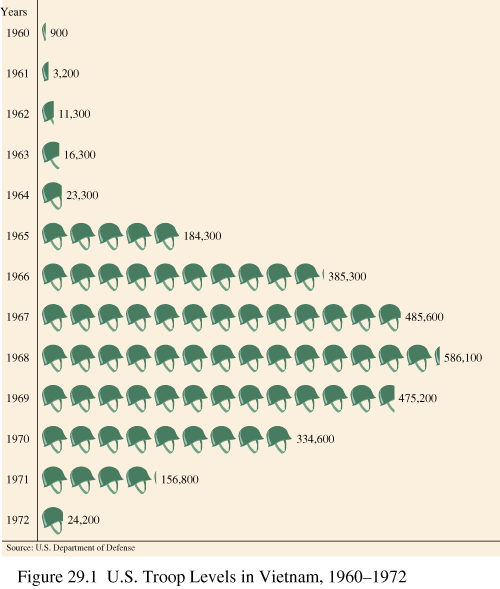
These losses were sustained without the implementation of an additional requirement for water delivery. According to the relevant US Army field manual, the water supply requirement for drinking, personal hygiene, food preparation, laundry, and medical treatment is six pounds of water per man per day. These levels provide enough water to support continuous combat operations for extended periods.
The implementation of this requirement would have added 158 tons per day, an additional load of 67% over the supply requirement without water. Unlike ammunition and food rations, which could be palletized and delivered by parachute without the need for special containers, water was difficult to stockpile during the periods when resupply was possible, for use when landings were not permitted due to weather or hostile fire. The official optimism of US commanders regarding resupply at Khe Sanh notwithstanding, the Americans would not have been able to provide the base with water under the existing tactical conditions.
By March the PAVN began withdrawing from the Khe Sanh area, and in April the Marine regiment was replaced, allowing it to withdraw via the newly reopened Route 9. The primary goal of the American forces at Khe Sanh was to destroy large numbers of North Vietnamese soldiers. In this they were successful.
Although the official body count of enemy soldiers killed at Khe Sanh was 1,602, the US command placed the total number of North Vietnamese at between 10,000 and 15,000 killed in action. American deaths sustained in the siege itself, plus mobile operations in the Khe Sanh tactical area after the siege, totaled approximately 1,000 KIA. In a war that focused on kill ratios and body counts as a measure of success, Khe Sanh was placed in the win column by the American military.
As with the Americans at Khe Sanh, the French garrisoned Dien Bien Phu as "bait" for the Vietnamese NVA and NLF forces. An American observer there reported that the French base could "withstand any kind of attack the Viet Minh are capable of launching." When the Viet Minh knocked out the airfield at Dien Bien Phu, resupply became impossible and the French became isolated and vulnerable. On May 7, 1954, after sustaining heavy losses, the French were forced to surrender. The very next day the Indochina phase of the Geneva Conference began. France's loss at Dien Bien Phu led directly to their withdrawal from Indochina.
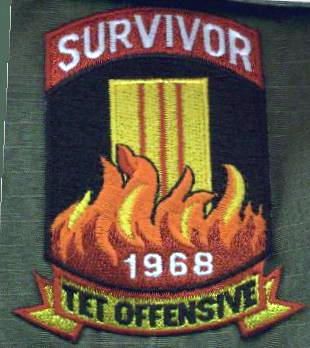 Courtesy: bvapush.pbworks.com |
Victory in combat, however defined, often hangs by a tenuous thread. Even with the claim of victory by the US at Khe Sanh and during the Tet 1968 fighting in general, the psychological victory of the NVA and NLF during this period led to the beginning of the end for the United States in Vietnam. It was during the 1968 Tet Offensive that opposition in the US to the war in Vietnam, in terms of regarding involvement as a mistake, first rose above 50 percent and exceed the level of support.
Approximately one fourth of all the television film reports on the evening news programs in the US during February and March, 1968, were devoted to portraying the situation of the Marines at Khe Sanh. Had the North Vietnamese simply interdicted the water supply of the Marines at the Khe Sanh Combat Base in 1968, thereby forcing the Marines to evacuate and inflicting heavy casualties upon them in the process, the United States could have easily have met a fate similar to that of the French.
Have we learned our lesson? I doubt it. Did the North Vietnamese lose the battle and win the war? Absolutely – if it’s only body count that mattered with respect to the battle itself. As a combat Marine, in and around Khe Sanh, Danang and other locations, it was two years later and I had landed. I also realized for the first time what a huge mistake the US had made as we touched down on the airstrip. The countdown for my rotation had started the very minute I landed in Danang.
To my brave brothers who were killed or wounded at Khe Sanh– thank you. To all who were killed, wounded, came back psychologically scarred or, well, and just came back – thank you. To those of us who are still around and have not succumbed to the diseases that have manifested themselves from the likes of Agent Orange or PTSD - thank you. To those of you who have succumbed – thank you. To the citizens of Vietnam – thank you for taking me back and allowing me the privilege of trying to do some good.
We were all combatants, formidable combatants. The memories live on, and the US continues to think it can influence nations that have been at war for generations as a result of religious differences, colonization, invasions, etc. Innocents are lost on all sides. Has the US learned anything at all? Just check how many US and allied troops as well as friendly’s are killed or maimed each day in Afghanistan, Iraq, and Pakistan. Just check how many of us die each day as a result of Agent Orange. No. We have not learned a thing.
Much of this was taken, with the exception of my obvious comments, from Wikipedia[2].
Other material is attributed to an eye witness account and article by Peter Bush[3].
[1] Project Renew: Explosion wounds four ethnic minority men near former U.S. Marine base at Khe Sanh
[2] Wikipedia: Battle of Khe Sanh
[3] Nobody Gets Off the Bus: The Viet Nam Generation Big Book
===================================================
 Chuck Palazzo is a Marine Corps Vietnam Veteran, the Interim Editor for Agent Orange, and a longtime Vietnam Veterans Against the War Member. Chuck Palazzo has spent years since the war studying the impacts and effects of Agent Orange, a defoliant chemical sprayed by the U.S. govt. on the jungles of Vietnam. He says Dioxins have been re-discovered to cause all sorts of damage to humans. These include Heart Disease, Parkinsonism, Diabetes etcetera. Dioxins are already known to produce serious birth defects and a variety of cancers. The chemical is still sold in Third World Countries and causing the same problems.
Chuck Palazzo is a Marine Corps Vietnam Veteran, the Interim Editor for Agent Orange, and a longtime Vietnam Veterans Against the War Member. Chuck Palazzo has spent years since the war studying the impacts and effects of Agent Orange, a defoliant chemical sprayed by the U.S. govt. on the jungles of Vietnam. He says Dioxins have been re-discovered to cause all sorts of damage to humans. These include Heart Disease, Parkinsonism, Diabetes etcetera. Dioxins are already known to produce serious birth defects and a variety of cancers. The chemical is still sold in Third World Countries and causing the same problems.
We at Salem-News.com welcome Chuck aboard and look forward to sharing more of his stories with our readers in the future.
Articles for February 10, 2010 | Articles for February 11, 2010 | Articles for February 12, 2010
Quick Links
DINING
Willamette UniversityGoudy Commons Cafe
Dine on the Queen
Willamette Queen Sternwheeler
MUST SEE SALEM
Oregon Capitol ToursCapitol History Gateway
Willamette River Ride
Willamette Queen Sternwheeler
Historic Home Tours:
Deepwood Museum
The Bush House
Gaiety Hollow Garden
AUCTIONS - APPRAISALS
Auction Masters & AppraisalsCONSTRUCTION SERVICES
Roofing and ContractingSheridan, Ore.
ONLINE SHOPPING
Special Occasion DressesAdvertise with Salem-News
Contact:AdSales@Salem-News.com

googlec507860f6901db00.html



Terms of Service | Privacy Policy
All comments and messages are approved by people and self promotional links or unacceptable comments are denied.
G 2/3; February 14, 2010 8:15 pm (Pacific time)
in memory of those who died on operation Pegasus-Scotland II, Quang Tri province.,68',They Walked The Walk! Semper Fi.
Jim February 14, 2010 7:26 am (Pacific time)
Chuck I see you mentioned you were in recon, was this a Force Recon unit? Curious, I'm a few years ahead of you regarding time served in 'Nam, where did you go to Jump School? Many years earlier it was at numerous locations Like Ft. Benning and Bragg.
Dexter February 13, 2010 12:09 am (Pacific time)
Jim thank you for the link, very interesting, with some good humor thrown in there as well :) . I hear what you say Chuck, I could not agree with you more. Keep up with the good writing.
Chuck Palazzo February 12, 2010 5:55 pm (Pacific time)
Robert- Thank you so much and thanks for validating some of what I had researched and wrote. I have spoken to many Marines who were at Khe Sanh during 1968 and they tell the same sad stories - the conditions were just horrendous. I know from being in the bush, conditions were bad enough as we were getting run over time and again by the NVA and VC - what we would do for water and a dry pair of boots! Brother, all I can say is, get your claims filed and get them filed ASAP. 3 more diseases have been added to the list of presumptives bringing the count to 15. The DVA IS accepting claims for those additional 3, yet they have not received final administrative approval to process all the way through yet. I believe they will - Shinseki is up to his eyeballs, but as a former combat soldier himself, he knows - and he is very perturbed that 40 years later, he as Secretary is still dealing with AO and related illnesses. Thank you brother and be well. Semper fi! Chuck PS...by the way, do you know Suel J. from Alaska as well?
Chuck Palazzo February 12, 2010 5:48 pm (Pacific time)
Dexter- If we continue to remind people, maybe, just maybe, history won't repeat itself. But as I stated, just look at the body count numbers each day in Afghanistan, Iraq, Pakistan - my brother, I don't think we have yet learned. Thanks for reading and commenting. Chuck
Chuck Palazzo February 12, 2010 5:46 pm (Pacific time)
Jim, Thanks much for adding the additional facts. Excellent site and some very valuable information. As I had mentioned, we kicked butt - no doubt, but unfortunately for all of the friendlies involved, this was all part of the grand plan of General Giap. As you know, I stated I was in and around Khe Sanh 2 years later - but there were several Marines that had been on their 2nd and 3rd tours who were at Khe Sanh during 68. The conditions, lack of bad planning and especially the water situation put our brothers in harms way - big time! Westmoreland was eventually fired as a result of this and several other blunders. As a combat Marine and volunteer as well, I know us. As a RECON NCO I can add, we were so crazy, those that fought us must have wet their pants knowing they were about to engage us. Again, thanks for the additional facts. Chuck
Jim February 12, 2010 3:32 pm (Pacific time)
Go to the below link, it discusses the TET offensive in a no-nonsense manner to help supplement this article: http://www.rjsmith.com/war_myth.html
Jim February 12, 2010 3:27 pm (Pacific time)
Dexter try putting in "Myths about Vietnam" in a search engine and see how many different Vietnam veteran organizations and individuals clear up considerable misinformation that has been out there for far too many years. What is also something people forget to consider is that many professional soldiers from the countries you mentioned who served in Vietnam were also WWII and Korean War veterans. It was these professionals who trained me and gave me a leg-up in dealing with a ruthless enemy.
Dexter February 12, 2010 2:25 pm (Pacific time)
It's good to hear that some people out there are still keeping this memory alive. I have always been fascinated about the Vietnam era, and I do still think this has to be one of the most hardest most aggressive time periods for the American, Australian, Canadian and New Zealand military history, since WW1 and WW2. There is still so much hidden or forgotten stories that related to this period of time. Great story Chuck.
Robert W. Plyler February 12, 2010 3:07 am (Pacific time)
I was one of the few lucky Marines stationed at Khe Sanh the entire time of the siege of 1967. I came away without a physical wound from a rocket, rifle or arty. I was a Lance Corporal with a Weapons Platoon. for the 1st. Bat. 9th. Marines of the 3rd. Mar. Div. I have never filed for or received benefits of any kind from being exposed to Agent Orange. I do have many medical problems, of which at least some of them could very well be traced to the exposure to it. I've always felt that why should I complain, when I had so many friends that had suffered and lost so much more then I did or those who paid the highest possible price, with their life. As far as the water situation at Khe Sanh went, I spent 2 1/2 months without a shower. I'm unable to recall a time while I was there, that I had enough water for drinking, cooking and brushing my teeth all in the same day. We had to defecate in sand bags while either in our bunkers or trenches, since every time we’d attempt to go to an outhouse, it would trigger incoming artillery to the compound. The NVA had every outhouse on the base plotted, just as they had every square inch of the runway of the LZ. As far as the air drops of rations, ammo and water goes, I wasn't able to keep track of how much landed on the other side of the compound barbwire, which the NVA ended up with. Now at the age of 60 years old, I’ve been advised by the Marine Corps that the water I used at Camp Lejeune, N.C. was found to be contaminated during the time I was stationed there in the early to mid 1970’s. As a Marine in war, I expected things to happen as they did at Khe Sanh. I had enlisted on my own, not drafted, to fight a war that at the time I thought was a war that needed to be fought. But now to find out some 35 years after the fact that the water given to myself and so many more, wasn’t fit to drink. That makes me damn mad. Due to the medical conditions I have, I’m unable to obtain insurance from my employer because of the cost factor to them. So I depend on my wife’s employers insurance for coverage. Well I for one plan to file for any and all available benefits offered by the Government, if current proposed legislation is passed, regardless of what branch it may be (VA or DOD). I would advise everyone to keep tabs on this legislation and encourage your representatives in Washington D.C., to do the same and vote the way they should. Respectfully Robert Plyler Kodiak, Alaska
[Return to Top]©2025 Salem-News.com. All opinions expressed in this article are those of the author and do not necessarily reflect those of Salem-News.com.